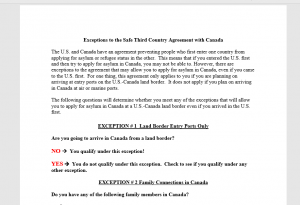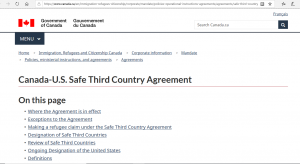

1. Important Links
CLICK HERE, for trying to use Notice of Application.
CLICK HERE, for trying to get a motion to extend time for A.J.R.
CLICK HERE, for background on the loophole.
CLICK HERE, for abuse of loophole in S3CA.
CLICK HERE, for the Canada/US Safe 3rd Country Agreement.
CLICK HERE, for the Immigration and Refugee Protection Act.
2. Background Information
The Federal Court has shot down multiple attempts to use application for judicial review (Section 18 of Federal Courts Act) to correct this problem. So, now the next approach taken: ask for straight-up enforcement of how the agreement was “intended” to be.
Specifically, it was never meant that anyone could bypass the S3CA simply by going around official checkpoints.
3. New Attempt: Statement Of Claim
- The Safe Third Country Agreement (S3CA) was signed between Canada and the United States on December 5, 2002, under then Prime Minister Jean Chretien.
-
The Safe Third Country Agreement (S3CA) came into effect on December 29, 2004, under then Prime Minister Paul Martin.
-
The intention behind this agreement is to recognize that both countries are “safe” countries, and that “asylum seekers”, shouldn’t be “shopping around” for a better country to arrive at.
-
The Safe Third Country Agreement (S3CA) remains in effect legally, the only issue is of enforcing it properly.
-
Recently, however, more than 40,000 economic migrants (fake refugees) have come into Canada from the United States. This poses security and financial burdens.
-
Instead of deporting these illegal, economic migrants (fake refugees), the Federal Government has decided instead to take them in, at great expense to taxpayers.
-
By far the most common location is Roxham Road, in Quebec, which shares a border with New York State.
-
A loophole in the S3CA means this only covers “official ports of entry”, or official land border crossings. This means the law can be circumvented merely by going AROUND any official border crossings.
-
While the wording in the official agreement may be poor, the intent was to avoid “asylum shopping”.
-
No reasonable person could interpret the agreement to mean that the agreement could be
bypassed by ignoring official checkpoints. That would reward lawbreakers. -
This is even more outrageous when considered that the US gets tens of thousands of asylum applications annually. Hardly a dangerous place.
(12) As specified on the Canadian Government’s own website, the point of the Safe Third Country Agreement (S3CA) is to prevent abuse. Here is a quote:
The Safe Third Country Agreement between Canada and the United States (U.S.) is part of the U.S.–Canada Smart Border Action Plan. Under the Agreement, refugee claimants are required to request refugee protection in the first safe country they arrive in, unless they qualify for an exception to the Agreement.
The Agreement helps both governments better manage access to the refugee system in each country for people crossing the Canada–U.S. land border. The two countries signed the Agreement on December 5, 2002, and it came into effect on December 29, 2004.
To date, the U.S. is the only country that is designated as a safe third country by Canada under the Immigration and Refugee Protection Act. The Agreement does not apply to U.S. citizens or habitual residents of the U.S. who are not citizens of any country (“stateless persons”).
(13) There is nothing vague or arguable about the intent of the agreement. People seeking asylum are required to apply for asylum in the first safe country they arrive at.
(14) Canada recognises the United States as a safe country. Period.
(15) It is further codified later on the Government website
Section 102 of the Immigration and Refugee Protection Act (IRPA) permits the designation of safe third countries for the purpose of sharing the responsibility for refugee claims. Only countries that respect human rights and offer a high degree
of protection to asylum seekers may be designated as safe third countries. To date, the United States is the only designated safe third country.
(16) And from reading Section 102 of the Immigration and Refugee Protection Act, we gain this information.
Regulations
102 (1) The regulations may govern matters relating to the application of sections
100 and 101, may, for the purposes of this Act, define the terms used in those sections and, for the purpose of sharing responsibility with governments of foreign states for the consideration of refugee claims, may include provisions
(a) designating countries that comply with Article 33 of the Refugee Convention and Article 3 of the Convention Against Torture;
(b) making a list of those countries and amending it as necessary; and
(c) respecting the circumstances and criteria for the application of paragraph
101(1)(e).Marginal note:Factors
(2) The following factors are to be considered in designating a country under
paragraph (1)(a):
(a) whether the country is a party to the Refugee Convention and to the
Convention Against Torture;
(b) its policies and practices with respect to claims under the Refugee Convention
and with respect to obligations under the Convention Against Torture;
(c) its human rights record; and
(d) whether it is party to an agreement with the Government of Canada for the
purpose of sharing responsibility with respect to claims for refugee protection.
Source: https://laws-lois.justice.gc.ca/eng/acts/I-2.5/page-19.html#h-56
(17) The United States, being the only officially designated “safe country” certainly means that people are safe there.
(18) To reiterate, it is the complete flaunting of a legitimate international agreement that is the issue. The S3CA was NEVER meant to mean anyone can claim asylum in Canada if they merely bypass official checkpoints.
(19) Under 101(1)(e) of the Immigration and Refugee Protection Act, so called “asylum seekers” who enter Canada illegally via the US would be inadmissible anyways, even without the S3CA.
101(1)(e) the claimant came directly or indirectly to Canada from a country designated by the regulations, other than a country of their nationality or their former habitual residence; or
(20) Again, clearly this would make these illegal economic migrants ineligible.
(21) And to beat a dead horse, these illegal, economic migrants (fake refugees) would be ineligible under 34(1)(1.b) of the Immigration and Refugee Protection Act. This is on the grounds that it would be subversion against an institution or process.
34(1)(b.1) engaging in an act of subversion against a democratic government, institution or process as they are understood in Canada;
(22) Also, allowing these illegal economic migrants (fake refugees), into Canada from the United States arguably violates AMERICAN law. Consider Section 101(a)(42) of the Immigration and Naturalization Act.
(42) The term “refugee” means
(A) any person who is outside any country of such
person’s
nationality or, in the case of a person having no nationality, is outside any country in which such person last habitually resided and who is unable or unwilling to return to, and is unable or unwilling to avail himself or herself of the protection of, that country because of persecution or a well-founded fear of persecution on account of race, religion, nationality, membership in
a particular social group,or political opinion, or
(B) in such special circumstances as the President after appropriate
consultation (as defined in section 1157(e) of this title) may specify, any
person who is within the country of such person’s
(23) Please note: the Canadian Federal Court is not being asked to rule on the validity of US refugee laws. This is added to acknowledge that the US does offer refugee status to approved asylum applicants. Again, this is not an attempt to amend or alter US law.
(24) Allowing this to happen is not saved by Perogative Powers. True, the Executive Branch of the Federal Government has the power to make treaties, and has legitimate purpose.
(25) However this is a treaty signed by a previous administration, that of Jean Chretien in December 2002. The treaty is valid, binding, and to this date, has never been rescinded. The current federal government must respect that.
(26) If the current administration has no interest in enforcing the S3CA as it was intended, then perhaps they should leave the agreement entirely.
(27) As should be obvious from the content of the Statement of Claim, this case is not about money, or getting rich from it. It is about enforcing the integrity of existing border security laws.
(28) The Federal Government has an obligation to the public to enforce agreements in good faith, and to not allow loopholes to undermine public policy.
(a) To declare the entire Canada/US border an “official port of entry” or an “official border crossing” to close the loophole in the S3CA.
(b) To deport automatically illegal economic migrants (fake refugees) attempting to cross in the future.
(c) To retroactively void/deny or invalidate any existing or previous claims (where these illegal crossings happen) on grounds that it takes advantage of the loophole
